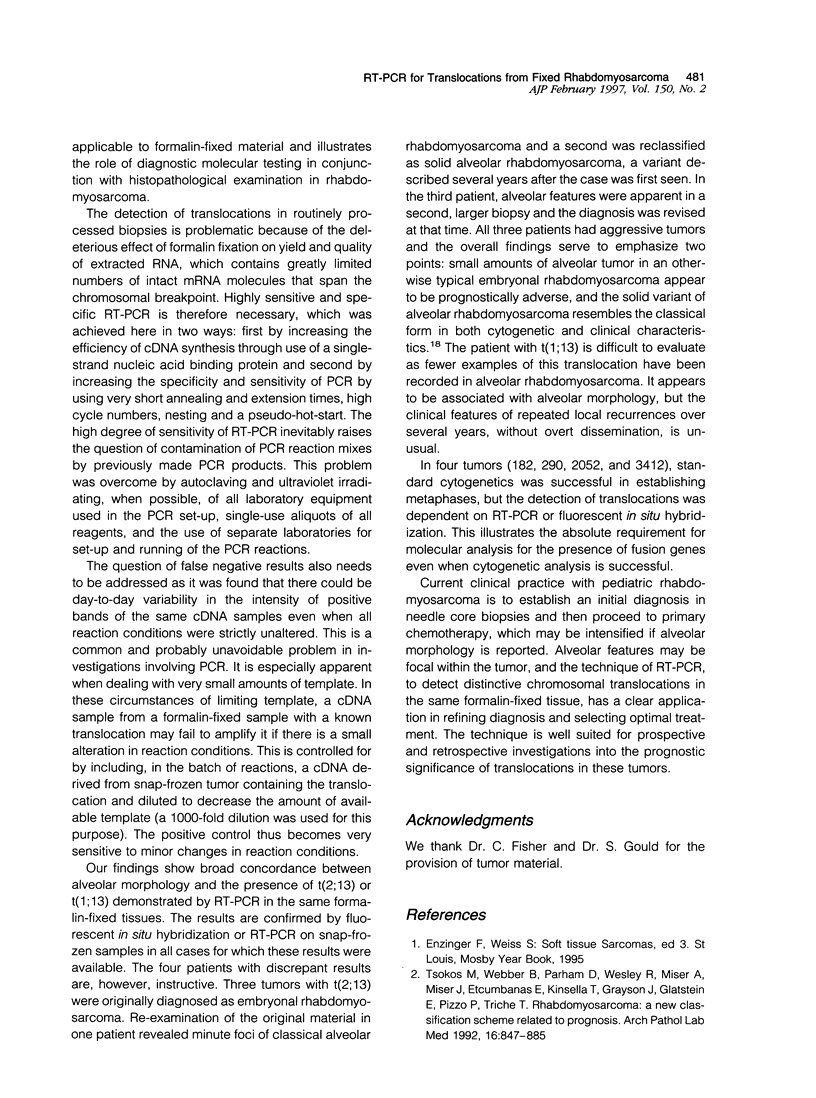Abstract
Detection of characteristic chromosomal translocations has aided diagnosis of the small round cell tumors of childhood and may help to stratify patients into clinical groups. The detection of the abnormalities by classical cytogenetic techniques has been supplemented by fluorescent in situ hybridization and reverse transcriptase polymerase chain reaction (RT-PCR). These techniques allow diagnoses to be made using only very small amounts of tumor tissue. We here describe a technique for the rapid and specific detection by modified reverse transcriptase polymerase chain reaction of characteristic chromosomal translocations of alveolar rhabdomyosarcoma with small amounts of formalin-fixed tissue as the starting material. Of 27 samples studied, 4 cases are described in which the detection of translocations by this method cast doubt on the original histopathological diagnosis. These cases demonstrate the critical diagnostic importance of the detection of these translocations in rhabdomyosarcoma.
Full text
PDF





Images in this article
Selected References
These references are in PubMed. This may not be the complete list of references from this article.
- Barr F. G., Galili N., Holick J., Biegel J. A., Rovera G., Emanuel B. S. Rearrangement of the PAX3 paired box gene in the paediatric solid tumour alveolar rhabdomyosarcoma. Nat Genet. 1993 Feb;3(2):113–117. doi: 10.1038/ng0293-113. [DOI] [PubMed] [Google Scholar]
- Bennicelli J. L., Edwards R. H., Barr F. G. Mechanism for transcriptional gain of function resulting from chromosomal translocation in alveolar rhabdomyosarcoma. Proc Natl Acad Sci U S A. 1996 May 28;93(11):5455–5459. doi: 10.1073/pnas.93.11.5455. [DOI] [PMC free article] [PubMed] [Google Scholar]
- Biegel J. A., Meek R. S., Parmiter A. H., Conard K., Emanuel B. S. Chromosomal translocation t(1;13)(p36;q14) in a case of rhabdomyosarcoma. Genes Chromosomes Cancer. 1991 Nov;3(6):483–484. doi: 10.1002/gcc.2870030612. [DOI] [PubMed] [Google Scholar]
- Davis R. J., D'Cruz C. M., Lovell M. A., Biegel J. A., Barr F. G. Fusion of PAX7 to FKHR by the variant t(1;13)(p36;q14) translocation in alveolar rhabdomyosarcoma. Cancer Res. 1994 Jun 1;54(11):2869–2872. [PubMed] [Google Scholar]
- Douglass E. C., Rowe S. T., Valentine M., Parham D. M., Berkow R., Bowman W. P., Maurer H. M. Variant translocations of chromosome 13 in alveolar rhabdomyosarcoma. Genes Chromosomes Cancer. 1991 Nov;3(6):480–482. doi: 10.1002/gcc.2870030611. [DOI] [PubMed] [Google Scholar]
- Douglass E. C., Valentine M., Etcubanas E., Parham D., Webber B. L., Houghton P. J., Houghton J. A., Green A. A. A specific chromosomal abnormality in rhabdomyosarcoma. Cytogenet Cell Genet. 1987;45(3-4):148–155. doi: 10.1159/000132446. [DOI] [PubMed] [Google Scholar]
- Fredericks W. J., Galili N., Mukhopadhyay S., Rovera G., Bennicelli J., Barr F. G., Rauscher F. J., 3rd The PAX3-FKHR fusion protein created by the t(2;13) translocation in alveolar rhabdomyosarcomas is a more potent transcriptional activator than PAX3. Mol Cell Biol. 1995 Mar;15(3):1522–1535. doi: 10.1128/mcb.15.3.1522. [DOI] [PMC free article] [PubMed] [Google Scholar]
- Galili N., Davis R. J., Fredericks W. J., Mukhopadhyay S., Rauscher F. J., 3rd, Emanuel B. S., Rovera G., Barr F. G. Fusion of a fork head domain gene to PAX3 in the solid tumour alveolar rhabdomyosarcoma. Nat Genet. 1993 Nov;5(3):230–235. doi: 10.1038/ng1193-230. [DOI] [PubMed] [Google Scholar]
- McManus A. P., Gusterson B. A., Pinkerton C. R., Shipley J. M. The molecular pathology of small round-cell tumours--relevance to diagnosis, prognosis, and classification. J Pathol. 1996 Feb;178(2):116–121. doi: 10.1002/(SICI)1096-9896(199602)178:2<116::AID-PATH494>3.0.CO;2-H. [DOI] [PubMed] [Google Scholar]
- McManus A. P., O'Reilly M. A., Jones K. P., Gusterson B. A., Mitchell C. D., Pinkerton C. R., Shipley J. M. Interphase fluorescence in situ hybridization detection of t(2;13)(q35;q14) in alveolar rhabdomyosarcoma--a diagnostic tool in minimally invasive biopsies. J Pathol. 1996 Apr;178(4):410–414. doi: 10.1002/(SICI)1096-9896(199604)178:4<410::AID-PATH508>3.0.CO;2-A. [DOI] [PubMed] [Google Scholar]
- Parham D. M., Shapiro D. N., Downing J. R., Webber B. L., Douglass E. C. Solid alveolar rhabdomyosarcomas with the t(2;13). Report of two cases with diagnostic implications. Am J Surg Pathol. 1994 May;18(5):474–478. doi: 10.1097/00000478-199405000-00006. [DOI] [PubMed] [Google Scholar]
- Tsokos M. The diagnosis and classification of childhood rhabdomyosarcoma. Semin Diagn Pathol. 1994 Feb;11(1):26–38. [PubMed] [Google Scholar]
- Tsokos M., Webber B. L., Parham D. M., Wesley R. A., Miser A., Miser J. S., Etcubanas E., Kinsella T., Grayson J., Glatstein E. Rhabdomyosarcoma. A new classification scheme related to prognosis. Arch Pathol Lab Med. 1992 Aug;116(8):847–855. [PubMed] [Google Scholar]
- Turc-Carel C., Lizard-Nacol S., Justrabo E., Favrot M., Philip T., Tabone E. Consistent chromosomal translocation in alveolar rhabdomyosarcoma. Cancer Genet Cytogenet. 1986 Jan 15;19(3-4):361–362. doi: 10.1016/0165-4608(86)90069-5. [DOI] [PubMed] [Google Scholar]
- Weber-Hall S., McManus A., Anderson J., Nojima T., Abe S., Pritchard-Jones K., Shipley J. Novel formation and amplification of the PAX7-FKHR fusion gene in a case of alveolar rhabdomyosarcoma. Genes Chromosomes Cancer. 1996 Sep;17(1):7–13. doi: 10.1002/(SICI)1098-2264(199609)17:1<7::AID-GCC2>3.0.CO;2-0. [DOI] [PubMed] [Google Scholar]
- Whang-Peng J., Knutsen T., Theil K., Horowitz M. E., Triche T. Cytogenetic studies in subgroups of rhabdomyosarcoma. Genes Chromosomes Cancer. 1992 Nov;5(4):299–310. doi: 10.1002/gcc.2870050405. [DOI] [PubMed] [Google Scholar]



